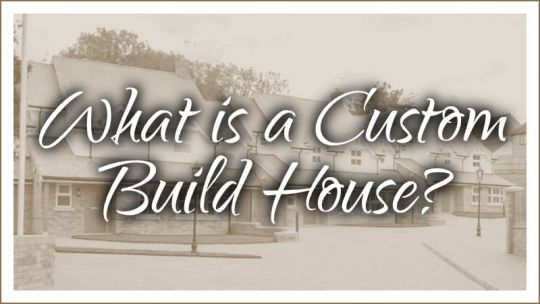What is self-build?
Self-build means you will be actively involved in acquiring land to build a home, designing and getting planning permission for this home, and building the home. You could do all the work yourself, but it is more usual after you have found the land to commission an architect to design the building and obtain planning permission and commission a builder or different building trades to build the home.
[BACK TO TOP]
What is custom build?
Custom build is where a house builder offers a site for sale with a ‘design and build’ service to allow you to tailor the home that is built on the site to your requirements. House builders will allow different degrees of customisation; some will allow you to fit out (lay flooring, install kitchens and bathrooms, tile, wallpaper and paint) the home yourself, while others will give you a range of fit and finishes to choose from that they will install.
[BACK TO TOP]
How does custom build work?
Register your interest with us today - we will help you identify the development that is right for you and explain the process to achieving a bespoke new home in more detail.
Reserve your plot - we'll keep your details while we finalise the development for the sales launch, upon which we will take you through the reservation process which includes financial qualification and appointment of your solicitors.
Design your home - upon securing your home plot, we will work with you to design a home from an indicative layout which includes planning drawings, submission of drawings for planning approval and technical drawings for construction.
We’ll build your new home for you - working with you throughout to design your home, choose your preferred specifications and finishes.
We will provide a 10 year warranty for your peace of mind.
Move in - enjoy your new custom-built home!
[BACK TO TOP]
Can I save money?
Yes. A properly planned and executed custom build project should show a saving over the purchase of a similar, ready built property; but more importantly you will get to build the home that you want, not the one that someone else wants you to have.
You will save money by cutting out ‘the middleman’ (i.e. the developer) and often by paying stamp duty, only on the land purchase price. Self-building is without doubt the most affordable and cost-effective way of building your dream home. However, the amount of saving is totally dependent on how much of the work you propose to do yourself and has a large number of risky elements!
Savings can also be made with custom build...
[BACK TO TOP]
What are the benefits of custom build?
Cost savings can also be made with a custom build, typically on the stamp duty on the land purchase, but also on the amount of work the developer may allow you to do yourself, and in the buying power the developer has with suppliers and the tradesmen used including buying land in bulk to create multiple plots!
Where custom build comes into its own is in all the other benefits not always readily apparent and not automatically available with a self-build. These are primarily but not exhaustive:
- A custom build home makes building your dream home quicker, easier, and also reduces the risk for you.
- Guided by an experienced developer you are less likely to make costly mistakes, whilst you still get to design your own home without the hassle and time needed to devote to the project.
- Finding an individual plot can be very difficult and more costly, especially in the more desirable areas. With custom build you have access to a plot that would otherwise be out of reach for the individual buyer and there is no need to be involved in the complicated, risky, and costly planning permission application and building control regulations.
[BACK TO TOP]
How much will the build cost?
The cost of the build will depend upon many different factors. Architectural style, size of property, ground conditions and level of specification, all have a bearing on the build cost as well as your location and the route chosen to undertake the construction work.
[BACK TO TOP]
Is timber frame cheaper than using masonry construction?
Timber frame and masonry are normally very similar in cost, though much will depend upon the specifics of the design. When comparing different build methods, it’s important to ensure that performance levels between different systems are similar and that the timescales involved are understood.
Timber frame is credited as being one of the fastest and most reliable methods of build as much of the work is done off-site in factory conditions. Faster build times reduce site preliminary and labour costs and as there is less chance for things to go wrong or delays caused by bad weather, the price of a timber frame build is much more certain.
[BACK TO TOP]
What are the benefits of timber frame?
It’s quick, easier to organise, easier to budget and has very good energy efficiency. It is therefore easier to comply with the ever-increasing demands of energy efficiency regulations and aspirations.
[BACK TO TOP]
How long will a timber frame last?
The short answer is that buildings constructed using timber frame construction will last as long as those constructed from any other mainstream construction method.
The products, systems and methods used today are underpinned by a rigorous environment of regulations, standards and third-party certification systems all designed to ensure that when adequately maintained all buildings perform to expected and accepted levels.
[BACK TO TOP]
Are timber frames more prone to fires?
No, all buildings constructed in the UK, no matter what method is used, must adhere to the same set of Building Regulations. The UK government collects statistics on fires in buildings and these demonstrate that the number of fires in timber frame buildings correlates very closely with the number of fires in buildings constructed in other ways.
[BACK TO TOP]
Is timber frame energy efficient?
Timber frame is one of the most energy efficient methods of construction available today. Modern Building Regulations require all new houses to achieve a prescribed minimum level of energy efficiency and these days the regulations really are quite stringent. Typically, the insulation is installed into the structure of the building at the factory making for more efficient and better insulation.
[BACK TO TOP]
What’s a good U-Value?
U-value is the number used to represent the amount of heat loss through building elements/material. As the number is a measure of heat loss, the lower the number the better. So, if your U-value is 0.15W/m2/K and your neighbour is 18W/m2K, your home is better insulated. It is important to remember that individual materials do not have U-Values, only complete elements, and that all the materials used in the construction of the element will contribute something to its performance.
It’s also equally important to note that U-Values are only one small part of what determines building envelope energy efficiency; providing an airtight structure, minimising thermal bridging, and having a sensible heating and ventilation strategy are equally important.
The lower the U-value you wish to achieve, the higher the cost. It is considered that anything below 0.14Wm2/K would not add sufficient cost benefit via reduced heating bills to outweigh the additional costs. Though its not always about cost, there is also the environment to consider through less use of energy.
[BACK TO TOP]
Can I use underfloor heating to all floors?
Yes you can. Many of our customers install underfloor heating on the ground floor of their properties (usually constructed with beam and block or concrete) and some install it on the first floor as well, although people often opt for conventional radiators upstairs.
[BACK TO TOP]
Will the floors squeak?
No. We provide open metal web floor joists rather than solid timber or I-joists. The plywood floorboards are nailed and glued to the joists to minimise the risk of squeaking. This type of floor construction makes it much easier to incorporate services into the floor zone without the risk of follow-on trades damaging the structure of the building. They also make it easier to include longer spans within the design of your new home.
[BACK TO TOP]
What are SIPs?
Structural Insulated Panels, or SIPs for short, typically consist of 2 layers of oriented strand board (OSB) with a central core of rigid insulation bonded to the OSB.
SIP panels are typically stiffer and stronger than conventional timber frame, require less internal studding and deliver higher levels of airtightness with reduced thermal bridging.
[BACK TO TOP]
What are Modern Methods of Construction (MMC)?
MMC is a ‘catch-all’ phrase that means different things to different people. With this in mind, in 2019 the Ministry for Housing Communities and Local Government published a definition which set out seven categories for defining the MMC framework split in 2 groups:
Off-site construction
- Volumetric modular: Segments of buildings manufactured offsite in 3D and fitted together onsite.
- Structural panellised: Wall and ceiling panels or frames that are manufactured offsite and assembled onsite.
- Offsite components: Structural elements, such as load bearing beams, columns and slabs that are built offsite.
- Additive manufacture: Printing parts of buildings, either on or off-site.
- Non-structural assemblies and sub-assemblies: Non-structural components that are manufactured offsite, such as pods, utility cupboards and risers.
On-site construction
- On-site building material improvements: Ways to reduce on-site labour by using new materials, such as large format blocks or pre-cut components.
- On-site process improvement: Use of innovative techniques, such as lean construction, digital augmentation, robots, drones, and exoskeletons.
[BACK TO TOP]
What percentage of homes in the UK are built by traditional methods?
The best estimates are that traditional construction accounts for over 90% of housebuilding in the UK. The remaining c.10% of homes use Modern Methods of Construction (MMC) and is expected to rise closer to 20% in the next 10 years.
[BACK TO TOP]
What heating system should I use?
The most energy efficient gas condensing boilers with an ‘A’ rating boast an ErP of 94% - easily exceeding the 92% minimum required by the current Building Regulations. However, under the government’s proposed decarbonisation measures, no new home can be connected to the gas grid from 2025. Existing homes can continue to use gas, at least for the moment.
The government has recommended a variety of sustainable alternatives, from wood-pellet boilers to electric or infrared radiators. But their preferred option is heat pumps which can massively exceed the 94% of gas boilers. Heat pumps extract heat from its surroundings – the air, the ground, a nearby body of water. Heat that would otherwise have gone to waste. However, there are many ‘buts’:
- It uses electricity which is roughly four times the price of gas. The heat produced and hence its efficiency is affected by changing temperature which when low will increase costs to produce the required heat.
- The most efficient system is a ground source heat pump. Its heat is drawn from the ground, a metre or so down and some 3-4 metres along as such the system requires a large plot in which to bury an array of pipework through which a fluid is pumped to extract the heat.
- To address the lower temperatures and fluctuating heat generated by both air and ground heat pumps, a much higher insulated house would be required.
- Installation costs of heat pumps is considerable higher than a gas boiler system, though government financial incentives are available to help reduce the cost.
[BACK TO TOP]
What are the pros and cons of gas versus electric heating?
Gas boilers are generally cheaper because gas is significantly cheaper than electricity. There are also more options for gas boiler units since most boiler companies produce this variant. Furthermore, gas boilers are better at meeting large demands for heating and hot water, so if you have a large property or if your family uses lots of hot water, gas boilers may be the better choice.
The main con of gas boilers is that there’s a risk of carbon monoxide poisoning or other hazardous gas leaks, but with proper installation, leak alarms, and regular maintenance and repairs from professionals these dangers can be averted. Another big con is if your house isn’t connected to the main gas grid, you’ll have to fuel your boiler with LPG tanks which you must constantly monitor to ensure you can order more before you run out.
Electric boilers offer cheaper installation fees because they’re compact and easier to install. There’s also no risk of any hazardous gases leaking from an electric boiler, and they operate more quietly than a gas boiler. Additionally, they require less maintenance than a gas boiler.
The biggest disadvantage of electric boilers is that your electricity bill may skyrocket because of running an electric heater more frequently in the winter. Any power interruptions may also cut off your heating, which could be a problem especially during snowstorms or harsh winters. You can avoid this by installing a back-up generator.
[BACK TO TOP]
NET ZERO - What does it mean?
‘Net Zero’ means achieving a balance between the amount of emissions produced, and those removed from the atmosphere in order to reduce global warming. Science has shown that human production of greenhouse gases, such as carbon dioxide, determines the overall extent of global warming.
What is a net zero building and how does it work?
A net zero building is typically connected to the grid and can sell excess power, as well as buy additional power during times of high energy demand. However, over the course of an entire year, this building will be net zero because it can cleanly produce as much energy as it consumes.
What does net zero energy mean?
It helps to conceptualize net zero energy in the context of a building like your home or office. If your home or office is working at net zero energy, that would mean that it is producing as much or more energy as it is using.
What does it mean to reach net zero?
Reaching net zero applies the same principal, requiring us to balance the amount of greenhouse gases we emit with the amount we remove. When what we add is no more than what we take away we reach net zero.
What does it mean to be net-zero energy ready?
As the name suggests, a net-zero energy ready building is one that is designed to be ultra-efficient, with the goal of being net-zero energy at some point in the future. For one reason or another, the building owner isn't able to afford the final steps, like a photovoltaic power plant, that would bring it all the way to official net-zero energy.
[BACK TO TOP]
What is Passivhaus?
The Passive House Institute (PHI) is an independent research institute that has played an especially crucial role in the development of the Passive House concept - the only internationally recognised, performance-based energy standard in construction. Passivhaus is a rigorous standard for building designs. Passivhauses often use 90 per cent less heating and cooling energy than an existing home and about 60%-75% less than an average new construction. They are so well designed and insulated that a full, traditional heating system is not considered necessary.
Passivhaus characteristics: When building a house to Passivhaus standard your house will benefit from: Excellent air-tightness, high levels of insulation, triple-glazed windows and, mechanical heat recovery and ventilation. All this comes at additional installation costs but is recoverable in the longer term through energy cost savings and social benefits to the environment which is not always about cost.
With the Passive House concept the heat loss that typically takes place in buildings through the walls, roof and windows is drastically reduced due to high-quality thermal insulation, windows with triple glazing, avoidance of thermal bridges, an airtight building envelope, and a ventilation system with heat recovery. This ensures that Passive House buildings can manage without a traditional building heating system. They are called "passive houses" because a major part of their heating demand is met through "passive" sources such as solar radiation or the heat emitted by occupants and technical appliances.
In a Passive House building the heat is retained for a very long time because it escapes very slowly. For this reason, active heating is only needed during extremely cold days. As such, only a very small amount of energy is required in total for providing the remaining heating requirement. In the summer (and also in hot climates), a Passive House building also offers advantages: among other things, the excellent level of insulation ensures that the heat stays outside, therefore active cooling usually isn't necessary in residential buildings. Due to the low energy costs in Passive House buildings, the utility costs are lower and more manageable.
[BACK TO TOP]
What makes a successful build?
- Great design which meets the needs of the whole family
- Excellent project management
- Within budget
- On time
- High quality – Defect free!
- Built safely
- Overcoming the unexpected
- A house to be proud of
- A sense of great achievement
- Compliments from family friends and neighbours
- How many WOWs you get!
[BACK TO TOP]






